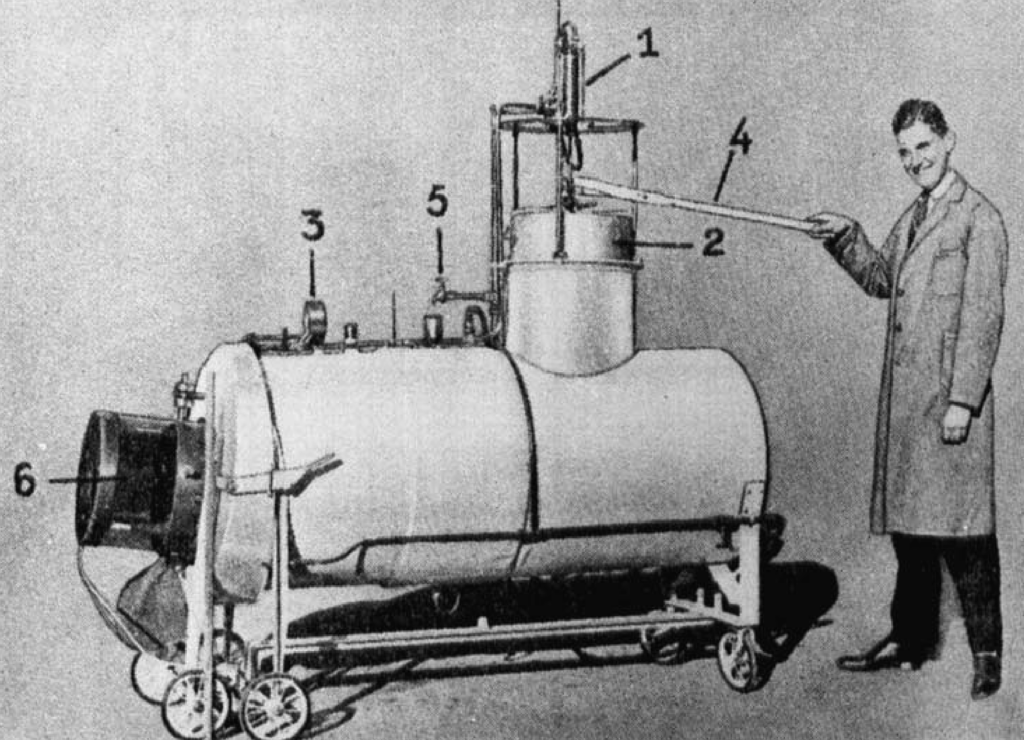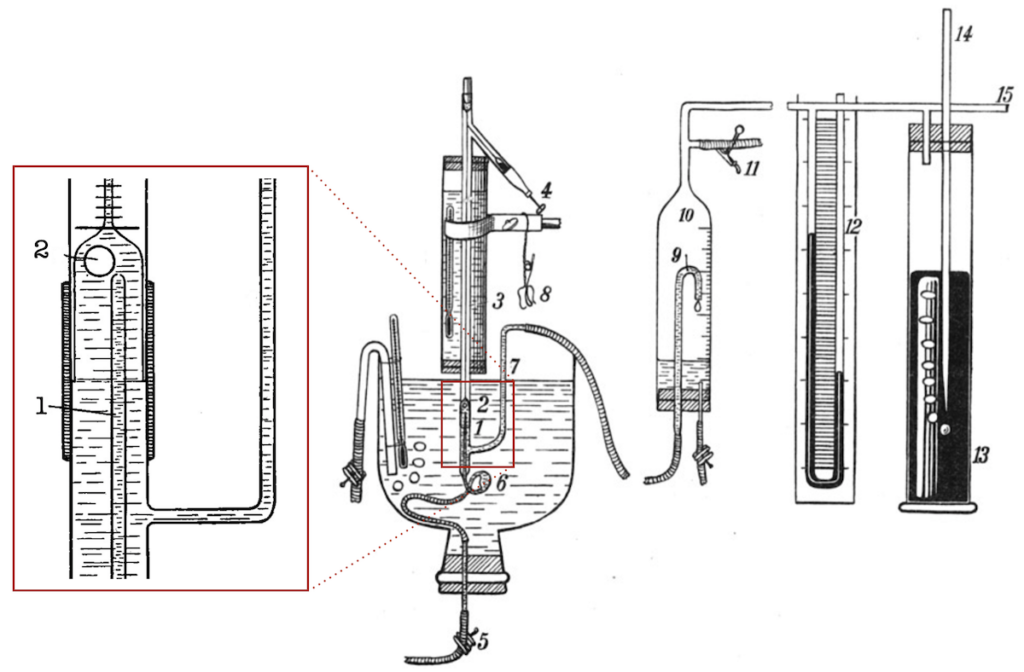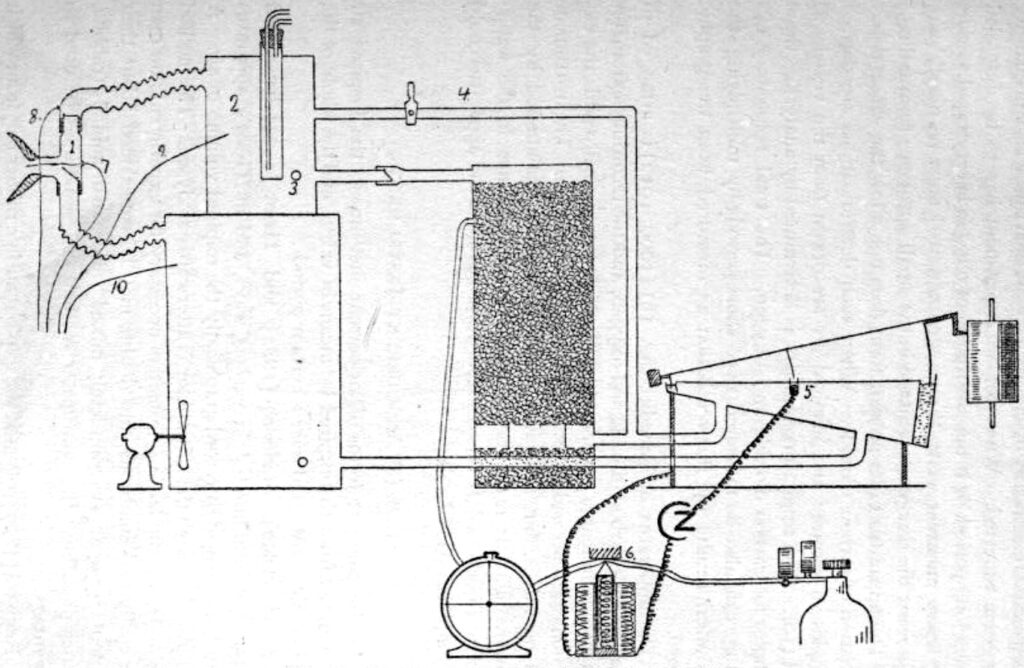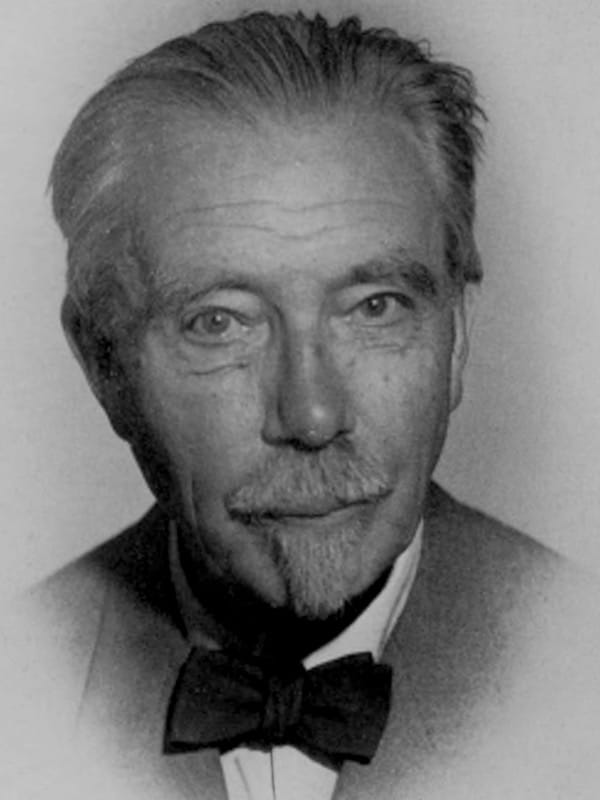August Krogh
August Schack Steenberg Krogh (1874-1949) was a Danish physiologist
Krogh was amongst the most influential physiologists in the first part of the 20th century. He was one of the first people to define comparative physiology, epithelial transport and exercise physiology as independent disciplines
His inquisitive mind and constructive skills saw him develop multiple apparatus that bear his name and includes a recording spirometer, precision pipettes, a respirator, a bicycle ergometer and improved methods for gas analysis.
He was responsible for publishing over 300 research papers across the span of his prolific career. Perhaps his foremost research contributions were his discoveries of the mechanism of gas regulation in blood capillaries in muscle and the mechanism of transport of oxygen across alveoli membranes to the blood stream; a finding that caused him to fall out with his then mentor, the famous Christian Bohr (1855–1911). Krogh was also the first to introduce insulin to Denmark and thereby save numerous lives affected by diabetes (his wife included).
As well as the Nobel prize in 1920, Krogh was the recipient of multiple Honorary Doctorates over his career from the Universities of Edinburgh, Budapest, Lund, Harvard, Oxford and Oslo as well as a member of many academies and learned societies such as the Royal Society of London. Krogh was a remarkable man and versatile genius whose contributions to physiology saw him dubbed (and rightly so) as the physiologist’s physiologist.
Biography
- Born on November 15, 1874 in Grenaa, Denmark
- 1893 – begins study in medicine at the University of Copenhagen and later switches to the field of zoology where a passion for respiratory physiology is sparked after attending a lecture by the eminent Dr Christian Bohr
I barely knew what physiology was, but when through Professor Bohr’s inspiring lectures and my own studies, I quickly realised this to be my actual field of study; it encompassed my warmest interests, as well as physics and biology, and brought me back to my childhood occupation
Krogh 1903
- 1897 – works in the Laboratory of Medical Physiology under Dr Christian Bohr and later becomes his assistant
- 1902 – attends an expedition in Disko, West Greenland where he designs equipment to measure the CO2 and O2 content in water and air samples which later leads into an interest in global CO2 balance. From this, he is among the first to make the revelation of increased atmospheric CO2 generated from the combustion of fossil fuels; a principle that was later studied by Swedish Chemist Svante Arrhenius who suggested increased atmospheric CO2 as an explanation for global warming
- 1903 – completes his PhD on cutaneous gas exchange in animals and proves that oxygen diffuses through the thin pulmonary membranes while the skin eliminated CO2; this supports the prevailing theory (held by his mentor) of the lung as a gland that secretes O2 and CO2
- 1904 – demonstrates for the first time, the blood-O2 equilibrium curve is sigmoidal in shape; a collaboration with Bohr and Karl Albert Hasselbach (1874-1962) describes the reduced affinity of blood for O2 upon addition of CO2; since known as the Bohr effect
- 1905 – married Marie Krogh (née Jørgensen, 1874–1943), a renowned scientist in her own right and much of August Krogh’s work was carried out in close collaboration with her.
- 1906 – is awarded a prize by the Vienna Academy of Science for his work in ‘Mechanisms of Gas Exchange in Lungs’ where he describes capillary contraction/dilation in response to a tissue’s oxygen requirement.
- During his work, he develops the Krogh microtonometer which allows for accurate gas analysis in blood; he begins experiments on oxygen transport in the lungs to the bloodstream
- 1907 – is appointed lecturer in zoophysiology at Copenhagen University and invites colleague Jens Peter Johannes Lindhard (1870-1947) a professor in Theory of Gymnastics, to embark on a series of studies over the next few years examining responses of metabolism, pulmonary ventilation and the cardiovascular system to physical exercise.
- Krogh designs his famous bicycle ergometer which comprises magnets and weights to quantify exercise intensity; the ‘feed-forward’ concept is established and describes how both heart rate and ventilation increase prior to afferent feedback from chemoreceptors
- The concept of oxygen debt is also introduced, that carbohydrates are burnt first then lipids follow during exercise and how increases in venous return during exercise leads to an increase in cardiac output
- 1908 – becomes an Associate Professor in Zoophysiology
- 1910 – publishes a series of seven papers titled the ‘Little Devils’ which proposes oxygen transport in the lung to the bloodstream as an exclusively passive diffusion process. This is contrary to the scientific views held by his mentor Bohr and leads to a falling out
The cutaneous absorption of oxygen cannot be regulated at all by the organism, hence I am of the opinion that with a probability almost amounting to certainty it is affected by plain physical powers – by diffusion.
Krogh 1904
The absorption of oxygen and the elimination of carbon dioxide in the lungs takes place by diffusion and by diffusion alone. There is no trustworthy evidence of any regulation of this process on the part of the organism.
Krogh 1910
- 1916 – publishes ‘The Respiratory Exchange of Animals and Man’
- 1920 – receives the Nobel Prize for Physiology or Medicine for his discovery of the motor-regulating mechanisms of capillaries. His intensive work in pulmonary physiology and energy metabolism leads him inevitably to study the mechanisms for O2 supply to working muscle as well as solute and water exchange between capillary blood and tissue.
- His collaboration with mathematician Agner Krarup Erlang (1878-1929), sees them develop the ‘Krogh-Erlang equation’ based on ‘Krogh’s cylinder model‘ to describe the phenomenon of capillary diffusion
- 1922 – publishes ‘The Anatomy and Physiology of Capillaries.’
- Krogh and his wife are invited to deliver lectures at the prestigious Yale University USA; whilst in America, they hear about the novel treatment of diabetes with insulin. They meet with one of the researchers behind the development of insulin, Frederick Banting (1891–1941) and acquire permission to manufacture and sell insulin in Denmark.
- 1923 – On his return to Denmark, he collaborates with Danish Physician Hans Christian Hagedorn (1888–1971) and carries out research on insulin; successfully extracts insulin from a bovine pancreas; founds the company Nordisk Insulinlaboratorium where he begins mass production of insulin for the treatment of diabetes (his wife included).
- 1932 – visits New York and observes a Drinker Respirator in use and considers it an important technical advance. In Denmark at the time, only the Drager pulmotor was in use and only for resuscitation. On his return to Denmark, begins work on his own respirator dubbed the ‘Krogh respirator’ – however only two were ever constructed, one adult sized tank respirator and one infant sized respirator
- 1944 – studied the driving forces for mass transport across biological membranes and demonstrates a novel form of mass transport termed ‘active transport’ in salt depleted frogs. The project is later taken over by a fellow researcher Hans Henriksen Ussing (1911-2000) at the bequest of Krogh who due to the German occupation of Denmark, suspends his work and flees to Sweden
- Krogh returns to Denmark after the war and spends his latter years researching energy metabolism of insects in flight. One of the methods used was a carousel where grasshoppers were suspended by a string on their back and air circulated so that they would fly hours on end while their velocity and changes in mass were recorded
- Dies on September 13, 1949 in Copenhagen
Medical Eponyms
The Krogh Model (1919)
Krogh’s cylinder model of the diffusion of O2 to the muscle is a simplified model of the tissue surrounding a capillary and was originally developed as means to analyse oxygen transport to tissue.
It assumes that oxygen exchange from the capillary occurs only with a surrounding finite cylindrical tissue region. The capillary itself is assumed to be cylindrical and of constant radius. The conditions of the model are:
- (i) that each capillary is the sole oxygen supply for the surrounding cylindrical tissue region
- (ii) oxygen tension is uniform in the tissue
- (iii) oxygen diffuses radially (and neglects axial diffusion) and consumption is uniform in the tissue.
Because of these conditions, the Krogh model underestimates true oxygen consumption in the tissue. Later modifications were incorporated which relaxed these conditions and allowed for improved physiological accuracies in this model.

(A). Krogh’s cylinder model. The geometry of a capillary surrounded by O2 consuming muscle tissue, where the O2 diffusion constant, d is the same everywhere governed by the O2 consumption, p likewise independent of x. R is half the distance between neighbouring capillaries each of radius, r and O2 tension of To. All of these four variables were experimentally obtained by Krogh.
(B) The Krogh-Erlang equation
The Krogh-Erlang equation assumes that an individual capillary by diffusion supplies O2 to the ‘Krogh cylinder’. The O2 tension at distance x from the capillary, Tx could not be obtained by experiment but was computed by the Krogh-Erlang equation
The Krogh Respirator (1932)
The Krogh respirator is a negative pressure respirator, in principle identical to the Drinker respirator. Krogh improved and simplified the construction, making the respirator easier to use, independent of electricity and considerably cheaper to construct.
Pressure fluctuations are generated by the movement of a spirometer bell driven by a water motor connected to an ordinary water pipeline. A disc valve controlled the direction of the water; thus, during inspiration, water is fed into a lower compartment of the piston cylinder, pushes the piston upwards which raises the spirometer bell and decreases tank pressure. This movement would then activate the disc valve which would then change the direction of the water from the lower to the upper compartment of the cylinder.

As the lower compartment discharges water, the piston is moved downwards and expiration is initiated. Pressure and tidal volume could be changed by adjusting the piston stroke and respiratory rate by changing the flow of water at the tap. A pump handle allowed the respirator to be manually worked if needed. Other features that were incorporated into the tank were a water jacket to regulate temperature, a hood which could be placed over the patient’s head to supply oxygen and the option to tilt the respirator in a 15degree head down position.
The Krogh Respirator saw very little clinical use and in the few cases where its use was described in papers, the majority of patients (poliomyelitis, barbiturate overdose, neurosyphilis) who were moribund upon initiation of ventilation, died within a short time period. In the papers where its use was described, it was stated that the respirator worked satisfactorily.
When respirators were advocated in hospitals, it was the Sahlin cuirass respirator that took hold of the market and ultimately, the Krogh respirator faded into obscurity. The fate of the adult respirator is unknown. The infant respirator became a part of the collection of the Medical Historical Museum in Copenhagen.
Krogh microtonometer (1908)
A small tonometer used to measure the oxygen and carbon dioxide tensions in arterial blood. Krogh’s method differed from his predecessors by using a very small gas bubble (2, in figure) of known dimensions which allowed for quicker gaseous equilibrium with a sample of blood obtained from an arterial puncture.

Krogh Principle (1929)
for a large number of problems there will be some animal of choice, or a few such animals, on which it can be most conveniently studied
Krogh 1929
This famous quote, stems from Krogh’s opening speech at the 13th International Physiological Congress on August 19, 1929 at the Harvard Medical School in Boston, published the same year in American Journal of Physiology under the title of ‘Progress in Physiology’
The comment on the right choice of animal model was made in direct connection with Krogh’s early studies on pulmonary gas exchange and Krogh explained:
Many years ago when my teacher, Christian Bohr, was interested in the respiratory mechanism of the lung and devised the method of studying the exchange through each lung separately, he found that a certain kind of tortoise possessed a trachea dividing into the main bronchi high up in the neck, and we used to say as a laboratory joke that this animal had been created especially for the purposes of respiration physiology
Little did Krogh know that the German-born biochemist and fellow Nobel Laureate Hans Krebs (1900–1981) would refer to proper choice of animal models as ‘The Krogh Principle’ in a review article in 1975
The Krogh spirometer
Krogh’s apparatus [1913] is a modification of an instrument constructed by Haldane and Douglas in 1912. Inverted bell-shaped chamber (~6-14L) with a counter-balancing weight for buoyancy and a water-filled container to provide a seal. Subjects breathe through a mask or mouth piece into the bell. The height of the bell subsequently reduces and lowers into the water as oxygen is consumed.

Carbon dioxide is absorbed in a vessel containing a charge of soda lime sufficient to absorb 1000 L of carbon dioxide, a quantity produced by a man at rest in about 70 hours. The recording spirometer gives a quantitative record of the respiratory movements and governs the admission of oxygen by closing an electric circuit (5).
The result is then read off a scale attached to the spirometer to indicate volume. Carbon dioxide is absorbed in a soda-lime filled container. Samples of the inspired and expired air can be drawn from the containers and the respiratory quotient determined.
Controversies
Bohr-Krogh conflict
The prevailing hypothesis for oxygen transport from the lungs to the blood stream at that time proposed an active mechanism of some sort at the alveoli-capillary junction. Bohr believed lung tissue to be similar to a ‘gland’ where oxygen was actively secreted. This would explain his findings of higher oxygen tension in arterial blood compared to alveoli air.
Krogh, as Bohr’s assistant, initially held the same view as Bohr. However, the invention of Krogh’s microtonometer allowed the prevailing hypothesis to be retested. In a series of experiments with colleague (later wife) Marie Jørgensen, Krogh attempted to replicate his mentor’s findings. The results were contrary to their expectations; oxygen tension was higher in the alveoli than the blood stream and the evidence instead pointed to oxygen transport as a purely passive process.
Krogh demonstrated the experiment on April 22, 1907 to Bohr. The differences in scientific views, saw the teacher-student relationship dissolve and Bohr never spoke to Krogh again. Perhaps out of respect to his former mentor, Krogh delayed the publication of his results until 1910 where he published a series of seven papers nicknamed ‘Little Devils’ – an apt name for a conclusion that went against the grain at the time.
Major Publications
- Krogh A. On the cutaneous and pulmonary respiration of the frog: A contribution to the theory of the gas exchange between the blood and the atmosphere. Skandinavisches Archiv fur Physiologie, 1904; 15: 328–419.
- Bohr C, Hasselbalch K, Krogh A. Über einen in biologischer Beziehung wichtigen Einfluss, den die Kohlensäurespannung des Blutes auf dessen Sauerstoffbindung übt, Skandinavisches Archiv fur Physiologie, 1904; 16: 401-412 [Bohr effect] and [English translation: Concerning a Biologically Important Relationship – The Influence of the Carbon Dioxide Content of Blood on its Oxygen Binding]
- Krogh A. Some new methods for the tonometric determination of gas tensions in fluids. Skandinavisches Archiv fur Physiologie, 1908; 20: 259-278
- Krogh, A. On the mechanism of gas-exchange in the lungs. The mechanism of gas exchange. Skandinavisches Archiv fur Physiologie, 1910; 23: 248-278
- Krogh, A. A bicycle ergometer and respiration apparatus for the experimental study of muscular work. Skandinavisches Archiv fur Physiologie, 1913; 30: 375-394
- Krogh A, Lindhard J. The regulation of respiration and circulation during the initial stages of muscular work. J Physiol. 1913 Oct 17;47(1-2):112-36.
- Krogh A, Lindhard J. The volume of the “dead space” in breathing. J Physiol. 1913 Oct 17;47(1-2):30-43.
- Krogh A. A study of the diet and metabolism of Eskimos undertaken in 1908 on an expedition to Greenland. 1915
- Krogh A. The respiratory exchange of animals and man. Longmans, Green and Co: London, 1916
- Krogh A. The number and distribution of capillaries in muscles with calculations of the oxygen pressure head necessary for supplying the tissue. J. Physiol. 52, 409–415.
- Krogh A. The rate of diffusion of gases through animal tissues, with some remarks on the coefficient of invasion. J. Physiol. 52, 391–408.
- Krogh A. The supply of oxygen to the tissues and the regulation of the capillary circulation. J Physiol. 1919 May 20;52(6):457-74. [Krogh Model]
- Krogh A. A Gas Analysis Apparatus Accurate to 0.001% mainly designed for Respiratory Exchange Work. Biochem J. 1920 Jul;14(3-4):267-81.
- Krogh A, Lindhard J. The changes in respiration at the transition from work to rest. J Physiol. 1920 May 18;53(6):431-9
- Krogh A. The anatomy and physiology of capillaries. Yale University Press, 1922
- Krogh A. The progress of physiology. Science, 1929; 70(1809): 200–204 [Krogh principle]
- Krogh A. En respirator efter Philip Drinker’s princip. Hospitalstid. 1932; 75: 629
- Krogh A. En vippebaare til kunstigt aandedræt. Militærlægen. 1934; 40: 107
- Krogh A. Osmotic regulation in aquatic animals. Cambridge University Press, 1939
- Krogh A. The comparative physiology of respiratory mechanisms. University of Pennsylvania press, 1941
References
Biography
- Hill AV. August Schack Steenberg Krogh, 1874-1949 Obit. Not. Fell. R. Soc. 1950; 7: 220-237.
- Rehberg PB. August Krogh, November 15, 1874-September 13, 1949. Yale J Biol Med. 1951 Nov;24(2):83-102.
- August Krogh (1874-1949), the physiologist’s physiologist. JAMA. 1967;199(7):496-497
- Schmidt-Nielsen B. August and Marie Krogh: lives in science. 1995
- Munck O. August Krogh – Nobelpristagare i fysiologi eller medicin 1920, Svensk Medicinhistorisk Tidskrift, 1997; 1: 85-90.
- Lindsten V. Schack August Steenberg Krogh – A versatile genius. The Nobel Prize. 2001
- Wang T, Hedrick MS. Special issue: Comparative physiology and the legacy of August Krogh, 1920-2020. Comp Biochem Physiol A Mol Integr Physiol. 2021 Jun;256:110930
- Larsen EH, Hoffmann E, Hedrick MS, Wang T. August Krogh’s contribution to the rise of physiology during the first half the 20th century. Comp Biochem Physiol A Mol Integr Physiol. 2021 Jun;256:110931
- August Krogh – Biographical. NobelPrize.org. Nobel Prize Outreach AB 2022
- Bibliography. Krogh, August 1874-1949. WorldCat Identities
Eponymous terms
- Krebs HA. The August Krogh principle: “For many problems there is an animal on which it can be most conveniently studied.” Journal of Experimental Zoology, 1975; 194(1): 221-226
- Sund Kristensen H, Lunding M. Two early Danish respirators designed for prolonged artificial ventilation. Acta Anaesthesiol Scand Suppl. 1978; 22(s67): 96-105
- McGuire BJ, Secomb TW. A theoretical model for oxygen transport in skeletal muscle under conditions of high oxygen demand. J Appl Physiol (1985). 2001 Nov;91(5):2255-65
- Gjedde A. Diffusive insights: on the disagreement of Christian Bohr and August Krogh at the Centennial of the Seven Little Devils. Adv Physiol Educ. 2010 Dec;34(4):174-85.
- Secomb TW. Krogh-cylinder and infinite-domain models for washout of an inert diffusible solute from tissue. Microcirculation. 2015 Jan;22(1):91-8
- Archiza B, Welch JF, Sheel AW. Classical experiments in whole-body metabolism: closed-circuit respirometry. Eur J Appl Physiol. 2017 Oct;117(10):1929-1937.
- Wang T. August Krogh, Carbonic Acid, Combustion of Coal, and Global Warming. Function (Oxf). 2021 Oct 13;2(6):zqab052.
[cite]
Emergency registrar at Sir Charles Gairdner Hospital, Perth


